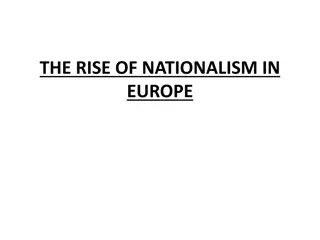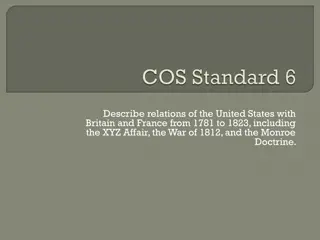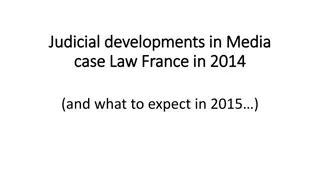
Enhancing Collective Bargaining in France: Trade Unions, CB System Overview
Explore the institutional framework of collective bargaining in France, including trade union dynamics, coverage rates, wages, and the evolution of the collective bargaining system. Learn about key case studies and the role of state intervention in shaping labor relations in France.
Download Presentation

Please find below an Image/Link to download the presentation.
The content on the website is provided AS IS for your information and personal use only. It may not be sold, licensed, or shared on other websites without obtaining consent from the author. If you encounter any issues during the download, it is possible that the publisher has removed the file from their server.
You are allowed to download the files provided on this website for personal or commercial use, subject to the condition that they are used lawfully. All files are the property of their respective owners.
The content on the website is provided AS IS for your information and personal use only. It may not be sold, licensed, or shared on other websites without obtaining consent from the author.
E N D
Presentation Transcript
Third panel Enhancing Collective Bargaining in Europe institutional framework and long term processes. Dialogue or discontent/protests: ways for trade unions to succeed Force Ouvri re, France
Table: - Trade unions, CB and social dialogue in France in a nutshell - The French Pensions Reform - Best case #1 S gur de la Sant - Best case #2 High Council on Remuneration, Employment and Productivity - Best case #3 CBA Metallurgy - Trade Unions and the 2024 Olympic and Paralympic Games
Trade Unions, CB and social dialogue in France - French trade unions: 8 main trade unions including 5 representative confederations at national and cross-sectorallevel the three main confederations are CFDT,CGT,FO -Trade union density (2019, French Labour Ministry): 10,3% in general (-0,9% since 2013) - 18,4% in the public sector and 7,8% in the private sector - Collective bargaining coverage rate: 98% according to ILOSTAT, 98% according to the OECD, 94% according to Eurofound 98% put forward by the French government during the discussions on the transposition of the EU Directive on Adequate Minimum Wages -Wages:minimum statutory wage at 1 398,70 /month (net) ;the median wage is 2150 (net) ;the average wage is 2630 (net)
Collective barganing in France - The French collective bargaining system: integrated system based on the hierarchy of norms and the principle of favour until recent Labour Law reforms (2016,2017) leading to a decentralized system in favor of CB at company level,including in SMEs without unions,and at the expense of sectoral CB and more generally workers generallevelof protection - Important level of state intervention through very frequent administrative extension of collective agreements at sectoral level (regardless of the membership in an employers association) explaining the important coverage of CB in France the application of CA to all employees in a company regardless whether or not they are union members is the 2ndrelevant factor -The case of the public sector (2021) : from regulations adopted unilaterally by public administration (PA) after consultation of ERB to collective agreements negociated by unions in the 3 branches of the PA
Collective barganing in France in numbers (2023) -Sharp increase in sectoral CB:1495 sectoral agreements concluded in 2022 against 1063 in 2021 and 1013 in 2020 the main themes are wages (691 in 2022 against 377 in 2021), occupational and wage equality (389 in 2022 against 231 in 2021) Cost-of-living crisis leading to partial automatic indexations of the statutory minimum wage triggering the legal obligation to revise conventionalwage minima at sectorallevel Other topics:VET (133) socialprotection (102) employment contract (78) working time (62) -Dynamic CB at company level in all companies:88 870 CA including 33 010 in SMEs (+18% from 2021) the main themes are participation/savings/profit-sharing (44%), wages, bonuses (22%), working time (20%),trade union rights,ERB (7%) Explosion in number of agreements dealing with trade union rights and employee representation (+133% from 2021) due to the renewalof a large part of "CSE" in France this year But only 51,3% of collective agreements are concluded by unions reps against 25,8% by workers directly through 2/3 majority in referenda,11,5% by elected reprensentatives not mandated by trade unions and 10% by elected representatives/employees with a mandate
What future for CB in France? (New Labour Law Reform for the Autumn) New CB decentralization towards companylevel Snap general elections on the 8th of July No majorityyet (1. NFP 2. Ensemble 3. RN) Political or institutional crisis? Different scenarios for TU and workers rights New Republic and New Constitution? New labour law reforms? Transposition of the AMWD
The French Pensions Reform
The French pensions reform - Still waiting the effects of past reforms: successive reforms of the French pensions system in 1993 (contribution period,replacement rate,no more indexation on wages), 2003 (retirement age, premium and discounts, arduousness), 2010 (retirement age, contribution period) and 2014 (arduousness,contribution period,socialcontributions) -The main elements of the reform: legal retirement age from 62 to 64 and accelerating the rise of the mandatory contribution period to 43,5 years ; no more special pensions schemes for new hires ;Senior Index coming back on past reforms:arduousness,minimum pensions the worst avoided thanks to trade union pressure:disability,women,long career -Entry into force of the reform on the 1st of September 2023 but stillwaiting for decrees of application and other regulations and unions are ready to challenge them in Courts to prevent unfair consequences for French workers the public administration is also in disarray!
The TU mobilization against the pensions reform - Main critics from TU: negative impact on women and the gender pensions gap ; risk to exacerbate existing inequalities in the pensions system (continuous decrease of the replacement rate) ; stronger risk for workers lives (cf. life expectancy in good health) ; no response to sustainability risks to the pensions system linked to employment (lowest senior employment rate, involuntary part time, job stability) ; no justification against demographic evolutions (cf. economic dependency rate);illegitimate reform no socialdialogue,art.49.3,rushed reform -The trade union mobilization in short: 14 days of national and intersectoral demonstrations across France (with collective action and strikes in some sectors and companies) from 19 January to 6 June 2023 in the inter-union setting with the 8 main trade unions and students/Youth organizations historical mobilization since 2010! Up to 3,5 millions of workers in the streets across France (07-23/03)
The reasons behind the "success" of the trade union mobilization Some details on the TU mobilization 14 days of national and cross-sectoral demonstrations and mobilizations across France (historicalmobilization in smallcities/villages) Building on the past success of the TU mobilization against the first draft in 2019 Using interactive map of demonstrations/strikes, communication on socialmedia,surveys digital tools: online petition, Strikes in key sector challenges on the right to strike and the minimum services levels (litigationto apply ILO case law) Historical movement (in a contextof professionalelections) unity of the French TU Multiple attempts to push through the trade union alternative reform through social dialogue/public including COR (NationalAdvisoryBodyon Pensions) consultations Developing a ETUC social project, broad support from academics,building on the CoR trade union alternative: Strategic litigation on the content and the form of the pensions reform Trade union solidarity: letters of solidarity, participation in demonstrations in France, solidarity action abroad (Belgium,Spain ) Ongoing TU activity at grassroot level (generalassemblies,localactions etc )
Best case #1 Sgur de la Sant (Healthcare) - - - In short:"S gur de la sant " CBA in the public hospital sector during COVID Time frame: 2018-2024 Organizations involved: TU from non-medical professions and organizations from medical professions with the French Ministry of Health - Issues: dis-investment in the French public hospital sector, negative real wage growth, lack of attractiveness leading to labour shortages - Results: comprehensive sectoral CBA and a new investment plan leading to pay rises, improved working and employment conditions, new hires, better training, support for digitalization and stronger territorial approach - How:strikes and demonstrations,public support for COVID-19, pressure through the National Recovery and Resilience Plan EXTENSION
Best case #2 High Council on Remuneration, Employment and Productivity - - - In short:a new nationalsocialdialogue body on pay,employment and productivity Time frame: october 2023-ongoing Organizations involved: one member for each representative social partners (5 TU, 3 EO) with 6 qualified personalities and 8 representatives of public administrations - Issues: rationalization of national social dialogue body, growing share at the statutory minimum wage,low dynamism of CB on sectoral minima,transposition of the AMWD - Results:national social conference on wages and creation of a new national social dialogue body on pay,employment and productivity,door to socialconditionalities - How:pressure in media,national/sectoral socialdialogue instances and in CB rounds at company level,demonstrations and strikes including the euro-demonstration on the 12th of October 2023 COHERENCE
Best case #3 CBA Metallurgy - - - In short:new sectoralcollective agreement in the metallurgy sector Time frame: 2016-ongoing Organizations involved: French representative TU in the metallurgy sector (FO, CFDT, CFE- CGC) and the main representative employers organization in the metallurgy sector (UIMM) - Issues: lack of attractiveness in front of growing labour shortages and skills mismatches, ensure a just transition to mitigate the green and digital transitions,cost-of-living crisis - Results: comprehensive sectoral CBA leading to higher sectoral minimum wage and adjusted wage classifications, improved working and employment conditions including on working time,support to paritarism on employment and VET - How:relative positive socialdialogue during/after the pandemic, also within the national socialdialogue body on Industry (CNI) IMPLEMENTATION
Trade Unions and the 2024 Olympic and Paralympic Games Social Charter (ILO,Construction sector) Recent hospitals, management) Strikes private (police, security, transport, waste Social seasonalworkers etc ) outcome (Youth, volunteers,
Thank you for your attention and special thanks to the interpreters! Please contact me to the following address for any question or precision: rlasserre@force-ouvriere.fr.






















